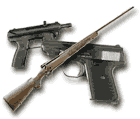The National Firearm Act of 1934 was enacted in reaction to activities of gangsters and outlaws of the time. The original law was passed as tax legislation in order to discourage ownership of certain firearms and destructive devices without creating an outright prohibition of the items. The tax on the weapons of $200 was a substantial amount of money in 1934. Because criminals were unlikely to register their NFA weapons, the government was able to use the possession of the weapons without proper tax as a tool to arrest and stop criminal activity. At the time the enforcement of the NFA was the responsibility of the Department of the Treasury.
The National Firearms act controls the ownership, transfer, and possession of a limited set of devices which include machine guns, silencers, short barreled rifles, and short barreled shotguns by requiring federal registration and a tax stamp for each device owned or transferred. The tax stamp is acquired in the registration process and requires specific paperwork. This paperwork referred to as a form 4 or form 1 typically requires a signature of local law enforcement, fingerprints and a payment of the $200 tax. Later the tax on ‘any other weapons was changed to $5. The tax is payable at manufacture and each time the NFA device changes ownership except when it is inherited or a dealer acquires the device.
The NFA also required serial numbers on firearms and made it unlawful to alter them. The process had the effect of registering all manufacturers, importers, and dealers.

 NFA Gun Trust Lawyer Blog
NFA Gun Trust Lawyer Blog

